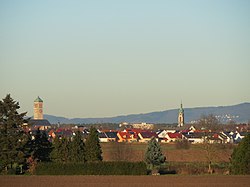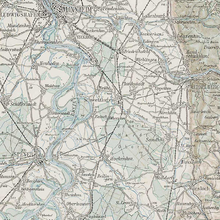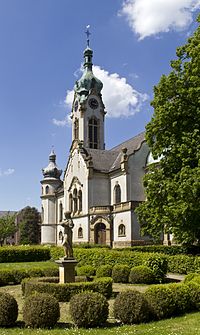Hockenheim
Hockenheim | |
|---|---|
 | |
Location of Hockenheim within Rhein-Neckar-Kreis district  | |
| Coordinates:49°19′05″N08°32′50″E/ 49.31806°N 8.54722°E | |
| Country | Germany |
| State | Baden-Württemberg |
| Admin. region | Karlsruhe |
| District | Rhein-Neckar-Kreis |
| Municipal assoc. | withReilingen,NeulußheimandAltlußheim |
| Government | |
| •Lord mayor(2019–27) | Marcus Zeitler[1](CDU) |
| Area | |
| • Total | 34.84 km2(13.45 sq mi) |
| Elevation | 102 m (335 ft) |
| Population (2022-12-31)[2] | |
| • Total | 21,745 |
| • Density | 620/km2(1,600/sq mi) |
| Time zone | UTC+01:00(CET) |
| • Summer (DST) | UTC+02:00(CEST) |
| Postal codes | 68754–68766 |
| Dialling codes | 06205 |
| Vehicle registration | HD |
| Website | www.hockenheim.de |
Hockenheim(German:[ˈhɔkŋ̍haɪm]) is a town in northwestBaden-Württemberg,Germany,about 20 km south ofMannheimand 10 km west ofWalldorf.It is located in theUpper Rhine valleyon the tourist theme routes "BadenAsparagusRoute "(Badische Spargelstraße) andBertha Benz Memorial Route.The town is widely known for itsHockenheimring,a motor racing course, which has hosted over 30Formula OneGerman Grand Prixraces since 1970.
Hockenheim is one of the six largest towns in theRhein-Neckar-Kreisdistrict; since 1999 the number of inhabitants exceeded the 20,000 threshold, thus the town received the status of a regional central town (Große Kreisstadt) in 2001. It is twinned with the French town ofCommercy,the German town ofHohenstein-ErnstthalinSaxonyand the American town ofMooresville, North Carolina.
Geography
[edit]Location and environment
[edit]Hockenheim is located in theUpper Rhine valleyon an old trade route fromFrankfurttoBasel.The brookKraichbachdivides the town in an eastern and a smaller western area, and flows into theRhineto the north nearKetsch.Hockenheim's totalmunicipalarea covers 3,484 ha, with ca. 28.8 percent used for settlement and transportation and ca. 45.9 percent for agriculture. The remaining area consists of ca. 22 percent forests and ca. 2.4 percent rivers and seas.[3]
The municipal area is divided into two large natural regions, the "Rheinaue" to the west and the slightly higher "Niederterrasse" to the east. The so-called "Hockenheimer Rheinbogen" is ameanderarea of the Rhine, which stretches over the municipalities of Ketsch, Hockenheim and Altlußheim. 30 parts of it with a total of 656 ha are under nature conservation. An additional area three times larger is designated as landscape conservation area, with less strict usage limitations. The "Rheinbogen" offers biologically diverse, secondary wetlands as habitat for endangered plants and animals, it is also an internationally important resting and feeding area for migrating birds in winter.[4]
Town structure
[edit]The central urban area forms one unit and is only divided into five districts for statistical purposes. Together with the central town several small settlements belong to Hockenheim: the industrial areas "Bahnstation Talhaus" and "Wasserwerk", the farms and houses "Insultheimerhof", "Herrenteich, Ziegelei" and "Ketschau, Ziegelei" as well as the deserted settlement "Westeheim".
History
[edit]
Stamped bricks of theRomanLegio XIV Gemina Martia Victrixwere found 1984 in a brick kiln during an excavation in Hockenheim. The stationing of this legion nearMainzfrom 71AD until 92AD indicates an early settlement in this area.[5]Hockenheim was first mentioned 769 as "Ochinheim" in a donation document of theLorsch Codex,an early monastery gift documentation. The name "Hockenheim" itself appeared first in 1238 in official documents. In theMiddle AgesHockenheim was owned by several alternating local authorities: the castle district Wersau, theDiocese of Speyerduring the 12th and 13th century, variousPalatinate( "Pfalz" ) rulers since 1286 and theElectoral Palatinate( "Kurpfalz" ) since 1462.
In the 17th century Hockenheim was severely devastated twice by French troops, 1644 in theThirty Years' Warand 1674 in theFranco-Dutch War.During this period the former cultivation ofhopsin the area was partly replaced withtobacco,brought into the country by the French. 1803 the Electoral Palatinate was dissolved and the village was integrated inBaden.With the growing tobacco crop the village flourished and was awarded town rights on 22 July 1895 byFrederick I, Grand Duke of Baden.
With the beginning of the 20th centuryasparaguscultivation replaced most of the remaining hops industry. At 29 May 1932 the Hockenheimring was opened with a motorcycle race. AfterWorld War IIthe decline of the cigar industry had begun, but Hockenheim was already known for its Hockenheimring and could expand in other industrial branches. January 1973 Hockenheim was assigned to the newly formedRhein-Neckar-Kreisdistrict. In 1991, Hockenheim was the host of the 11thBaden-WürttembergStateHorticulturalShow.
Politics
[edit]
The town is led by theLord Mayor( "Oberbürgermeister" ), who is elected directly by the population every 8 years; since 2004 this office is held by Dieter Gummer (SPD). Its Permanent Representative is the "Erste Beigeordnete", with the office designation of mayor ( "Bürgermeister" ). As of thelocal electionon 25 May 2014, the local council of Hockenheim consists of 22 members, who hold the title "Stadtraetin/Stadtrat", and the Lord Mayor presiding the council.
In 1975 the Hockenheim government agreed upon amunicipal association( "Verwaltungsgemeinschaft" ) with the neighboring villagesAltlußheim,NeulußheimandReilingen.Hockenheim is one of the six largest towns in the Rhein-Neckar-Kreis district; since 1999 the number of inhabitants exceeds the 20,000 threshold, thus the town received the status of a regional central town ( "Große Kreisstadt") in 2001.
Coat of arms
[edit]Adopted in 1609, thecoat of armsof Hockenheim has diagonally crossed silver hooks in a sign, below a crowned golden lion. The lion is the animal of the Electoral Palatinate, to which Hockenheim belonged; the hooks are probably derived from the place name. The form of the symbols was changed several times, but has been specified in its current form by municipal law since 1895.
Sport
[edit]
TheHockenheimring,a motor racing course built in 1932, has become the home of theFormula OneGerman Grand Prix.It has hosted this event over 30 times since 1970, including every year between 1986 and 2006. Since 2007 Formula One races in Germany are alternating annually between the Hockenheimring and theNürburgring;Hockenheim hosts the event on even years. The course is also used for several other motor racing events andopen-air concerts.After Nurburgring's withdrawal from 2015,Hockenheimringstarted hostingGerman Grand Prixannually since 2018. However, the track ownership and management and Formula One Management have not yet agreed a deal to extend the track's holding of the German Grand Prix beyond 2019.
Places of interest
[edit]
A museum for tobacco cultivation was founded 1984 as the first of its kind in Baden-Württemberg. Themotorsportmuseum opened near the Hockenheimring in 1986 and shows over 200 exhibits of historical motorcycles and engines. The "Gartenschaupark" was created in 1991 to host the State Horticultural Show and is, with an area of 16ha,Hockenheim's largest park.
Hockenheim's landmark is thewater tower,constructed in 1910 inArt Nouveau.Other buildings of historical significance include theProtestanttown church, a 1906Neo-baroquebuilding by architectHermann Behaghel,and the Catholic Church (1910), done in Art Nouveau with a high tower, byJohannes Schroth.The old Catholic church, with aclassicalhall (1817) and a lateGothicchoir tower (1490), serves as a community center today.
International relations
[edit]Source:[6]
Hockenheim istwinnedwith:
 Commercy,France,since 1970
Commercy,France,since 1970 Hohenstein-Ernstthal,Saxony,Germany,since 1990 (town in formerEast Germanybeforereunification)
Hohenstein-Ernstthal,Saxony,Germany,since 1990 (town in formerEast Germanybeforereunification) Mooresville,North Carolina,United States,since 2002.
Mooresville,North Carolina,United States,since 2002.
Atown sponsorship(German:Städtepatenschaft) forSambainSamba Department,Burkina Fasowas established in May 1985.
References
[edit]- ^Aktuelle Wahlergebnisse,Staatsanzeiger, accessed 14 September 2021.
- ^"Bevölkerung nach Nationalität und Geschlecht am 31. Dezember 2022"[Population by nationality and sex as of December 31, 2022](CSV)(in German).Statistisches Landesamt Baden-Württemberg.June 2023.
- ^(in German)Flächenerhebung 2011, Hockenheim, StadtArchived2013-02-17 atarchive.todayStatistisches Landesamt Baden-Württemberg, data as of 31. December 2011. Retrieved 3 January 2013.
- ^(in German)Hockenheimer Rheinbogen, Pflanzen und TiereLandesanstalt für Umwelt, Messungen und Naturschutz Baden-Württemberg. Retrieved 3 April 2011.
- ^(in German)Ulrich Brandl und Emmi Federhofer:Ton + Technik. Römische Ziegel.Theiss, Stuttgart 2010,ISBN978-3-8062-2403-0(Schriften des Limesmuseums Aalen.Nr. 61)
- ^"Hockenheim - Partnerstädte"(in German). Town council Hockenheim. Archived fromthe originalon 31 May 2016.Retrieved22 May2016.
External links
[edit]- Official website
 (in German)
(in German) - Nature conservation area "Hockenheimer Rheinbogen"(in German),Ministry of Environment Baden-Württemberg, retrieved 26 August 2015




